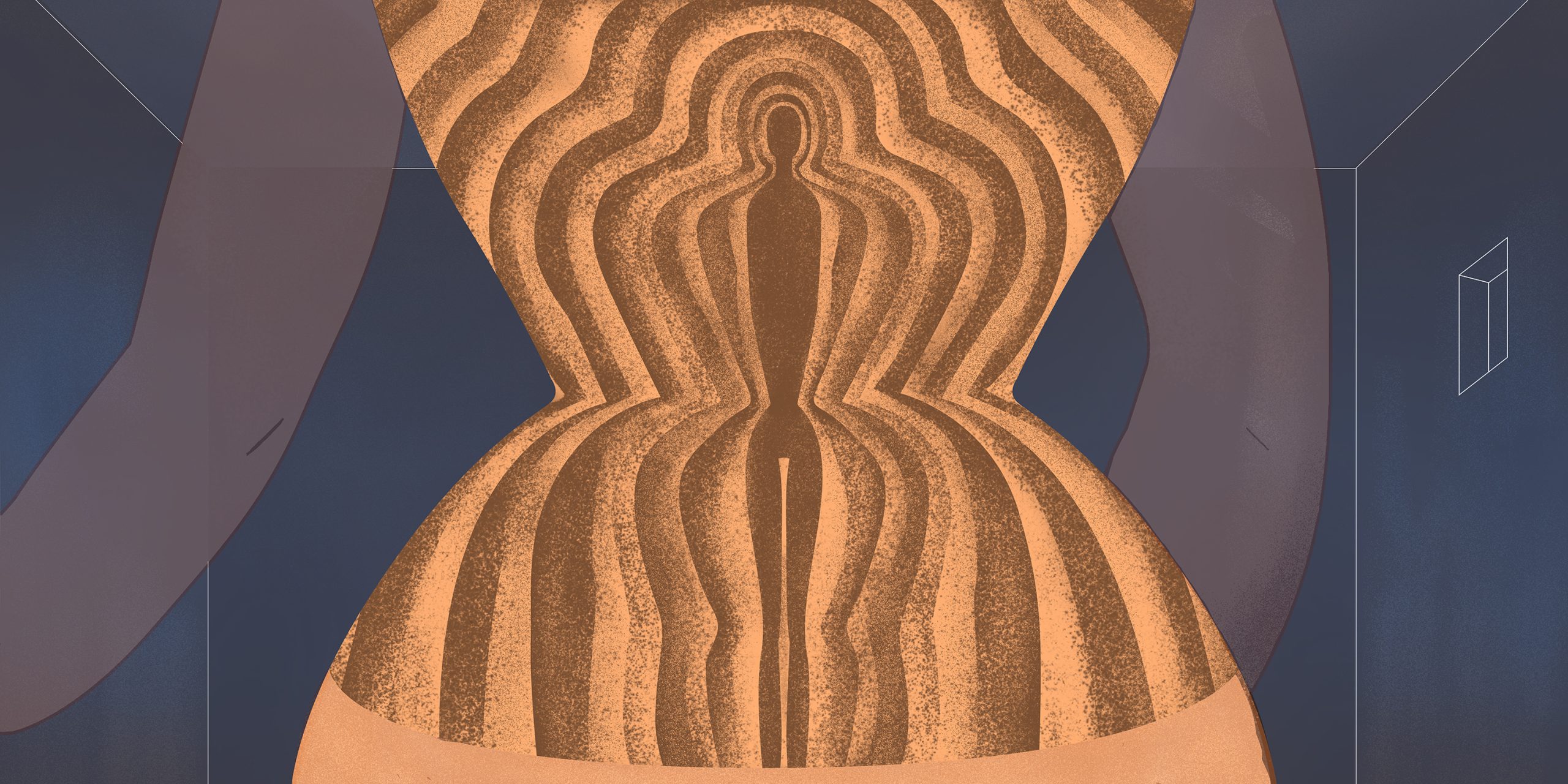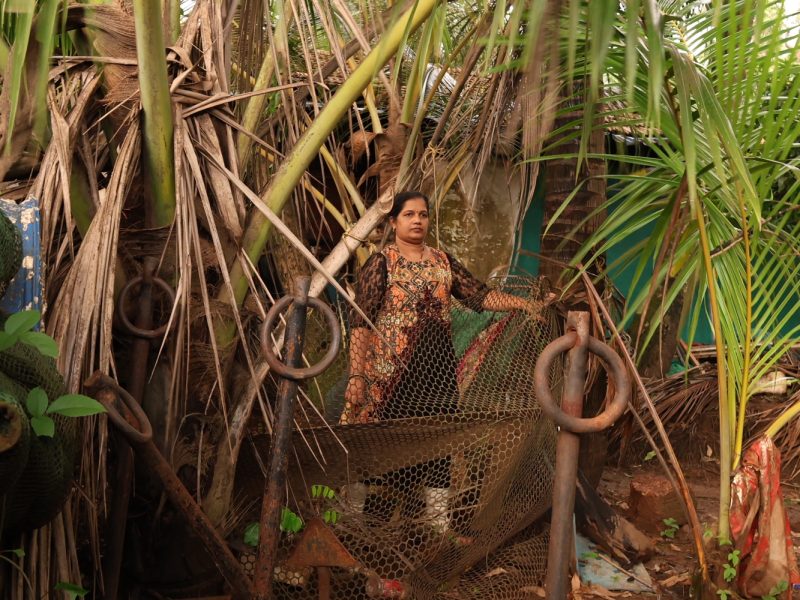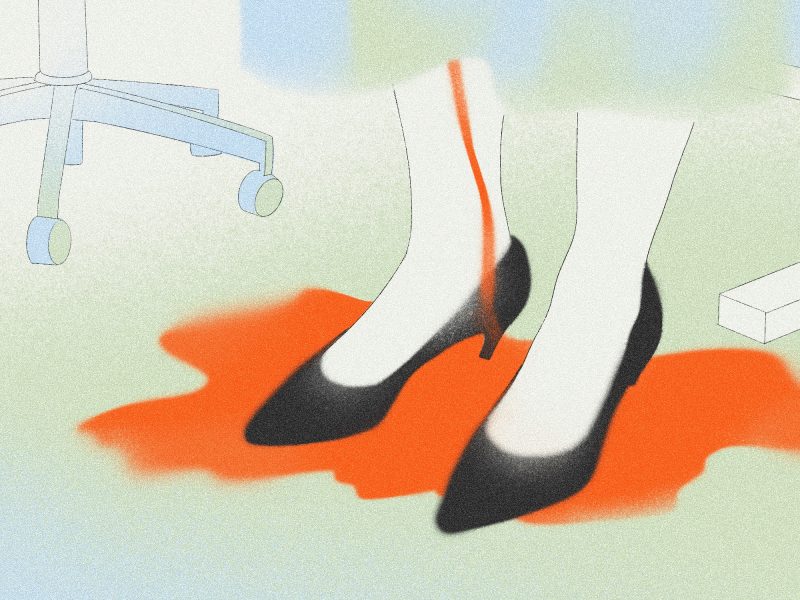Why eating disorders are so prevalent in Latinx and AAPI communities in the U.S.
It was a summer morning in 2001 when 11-year-old Elizabeth Moscoso realized her body was growing in width “unlimitedly.” Before puberty, her figure had been slim, smooth, and long. But in recent months, it had become almost unrecognizable, as if it did not belong to her; her body suddenly covered in thick, black hair, and curves where there had once been straight lines. She desperately wanted to get rid of them. “This body…isn’t mine,” Moscoso, now 35, thought. That morning, she shared these thoughts with her mother, a Guatemalan immigrant who had moved to the United States decades prior. Leaving the kitchen, her mother returned and handed Elizabeth a solution: a dark gray faja.
A faja—a type of girdle that wraps tightly around the abdomen—is supposed to shape people’s, usually women’s, bodies to make them appear slimmer, giving them an hourglass figure. It’s also meant to increase sweating, and eventually, help with weight loss. Elizabeth wanted to feel pretty, and to her, that meant having a small waist, so she accepted her mom’s help and let her wrap her body in the faja. It was immediately uncomfortable; and soon, she began to sweat. Still, she felt determined: Elizabeth continued wearing the faja every day for the next month.
“I hoped that this would work, like a cocoon, and that after a while, I would come out beautiful and different, more like I’d always wanted to be,” she says.
Growing up, Elizabeth would watch Mexican telenovelas after school, enraptured by the beautiful women portrayed on screen. She also noticed a pattern: The women who found true and eternal love on these shows were usually pale, thin, and clean-shaven, their hair always perfectly curled. “Do I need to be like them to be loved?” she asked herself. But she wasn’t sure. Growing up in Southern California, in a Guatemalan and Ecuadorian household, she was surrounded by contradicting beauty standards. Her grandmother said beauty meant having curvy calves; her mom believed it was having hips and breasts, with a slim waist; her classmates believed it meant being extremely thin. Confused and desperate to fit in, it was around this time that Elizabeth began wearing the faja.
Soon after, she also developed an eating disorder. Within a matter of months, Elizabeth had begun an extreme dieting regime, and would hide herself in baggy clothes—even in summer. She began using hair removal creams on her arms, and later began bleaching the hair blonde.
“I was feeling uncomfortable and confused because I didn’t see my white peers experiencing the same,” Elizabeth says. “But I wasn’t sure what was going on with me; I did not have the language. I wanted to stop restricting and exercising compulsively but I couldn’t.”
Unfortunately, Elizabeth’s experience struggling with Western beauty standards isn’t an uncommon one. A study by Florida International University found that Latinx and Asian American and Pacific Islander (AAPI) communities have the highest rates of eating disorder (ED) symptoms in the United States. The main reason is that ethnic minority women who acculturate to Western society are at an increased risk of experiencing body dissatisfaction, due to contradicting beauty standards between their primary and assimilated cultures. In other words, people who come from non-American cultures—or were raised with traditions from other countries, like Elizabeth—often experience stress when trying to adopt the beliefs, attitudes, and behaviors of Western society in order to fit in with its dominant culture.
“For young people who need to feel like they belong to this country, physical appearance is often an element that provides a concrete way of knowing that if they lose weight, get thinner, and look like a white girl, then they will feel like they fit into this culture and be more accepted,” says Mae Lynn Reyes-Rodríguez, clinical psychologist and Associate Director of the Center of Excellence for Eating Disorders at University of North Carolina-Chapel Hill.
This is especially common in first-generation Americans, like Elizabeth, and immigrants who have lived more than 70% of their lives in the U.S., as highlighted in a study published by the International Journal of Eating Disorders.
This pressure has only been exacerbated with the rise of social media in recent years, as beauty standards continuously shift at a lightning pace. In the late 2010s, the growth of the wellness industry, influencer culture, and beauty/fitness content shaped women’s beauty ideals towards toned bodies achieved through exercise and “healthy” eating. But more recently, the rise of conservative aesthetics and the popularization of weight-loss medications like Ozempic have been shifting beauty standards again—this time toward bodies that are ultra-thin.
Today, Western beauty ideals promote a teenage—even prepubescent—body, despite the reality that even during their teenage years, people often feel insecure about their bodies and want to change them.
Because thinness is the goal, disordered eating habits that result in dramatic weight loss often don’t raise concerns from clinicians, often delaying diagnoses and care for those who are suffering. In fact, when patients lose weight, many say they are praised for prioritizing their “health.”
Clinicians also aren’t always able to see—nor do they actively look for—disordered eating symptoms in young women of color.
“Providers are trained to look for eating disorders through a white, Western lens,” says Ana Gardner, a Latina clinical supervisor and therapist at Equip, an organization that provides ED treatment in the U.S. “So if somebody doesn’t meet the typical profile, their symptoms might not be identified. There’s research that primary care doctors are less likely to screen BIPOC patients for eating disorders, even when there are very clear symptoms present.”
Shikha Advani, 25, an Indian American woman who grew up in Michigan, experienced this firsthand: After she rapidly lost weight at 15 years old, her doctors began congratulating her at every routine check-up.
Prior to that, growing up, Shikha had always had a larger body. Her family used to call her mota, the Hindi word for fat, and constantly gave her advice on why she needed to lose weight. Her classmates made fun of her in gym class because she couldn’t run, and taunted her with things like, “Why are you so slow?” or “You’re too big to keep up.” Sometimes it was more subtle: eye rolls, laughter, or whispers when she lagged behind.
“It wasn’t constant, but it stuck with me because it singled me out and made me very aware of my body in a way that felt shaming,” Shikha says.
When she saw her classmates start dating in middle school, Shikha didn’t want to be left out. So she decided she would lose weight—no matter what. She joined the cheerleading team and became a flyer, started running, and restricted her food intake. As she lost weight, the people around her took notice. But despite her efforts, she wasn’t asked to the school dance and was unable to find a significant other—something that only reinforced her idea that she needed to make herself literally and figuratively smaller.
Shikha had witnessed her mother go through a similar cycle of disordered eating when she was still just a baby. After 9/11, the “Global War on Terrorism” led to widespread racial and religious profiling of individuals perceived to be of Middle Eastern or South Asian descent. Her family was targeted.
“My mom wanted to stay small and take up less space, so she could assimilate to society and look like the white folks,” she says. “It was like that for me, as well. We wanted to matter less and to be seen less after all the trauma of 9/11.”
Now, Shikha has a tattoo on her right arm that says “take up space,” a reminder that the only way to help other people of color who experience EDs is by being visible and outspoken, something she tries to practice in her work today as an anti-diet nutritionist.
Shikha was initially drawn to this work because she wasn’t able to access the necessary resources for her own ED recovery—something common for many young people of color. In addition to prohibitive costs, ED recovery treatments in the U.S. also usually follow a Western approach that may reinforce the racism and sexism that contribute to these disorders in the first place. Gloria Lucas, founder of Nalgona Positivity Pride, an organization supporting people of color affected by ED, emphasizes that colonialism is deeply tied to the development and persistence of disordered eating in marginalized communities. It leads to food insecurity, the disruption of traditional food systems, the imposition of Eurocentric beauty standards, medical violence, and trauma from discrimination.
But even those who might accept a Westernized ED treatment often can’t access it. Most U.S. health insurance plans don’t cover the full cost of treatment. Medicaid is accepted by only a few ED clinics, and Medicare offers limited coverage and doesn’t include nutritional counseling.
“An eating disorder can be very expensive, especially depending on its severity,” Reyes-Rodríguez says. “Treatments require a team-based approach; there must be a doctor, nutritionist, therapist, and often a psychiatrist. The later it is diagnosed, the more expensive it becomes as people would need more effort and resources.”
For those who choose to pay for treatment out of pocket, the costs can quickly become prohibitive. Malena Román Giovanetti, 20, born and raised in San Juan, Puerto Rico, experienced this firsthand. Most of her childhood, she remained very healthy, but at 14 she began to struggle with disordered eating. At home, she watched as some of her relatives followed strict diets to modify their bodies; at school, she barely had any friends. Her ED became a coping mechanism to regain a sense of control. After four months, she told her mom, who quickly found the only clinic in San Juan—and the only clinic on the entire island of Puerto Rico—that offers ED treatment. It didn’t accept insurance, so her family paid out of pocket. Malena regained some weight, but continued to struggle with body dissatisfaction and intrusive thoughts. When the COVID-19 pandemic hit, she relapsed. Her family had to pay even more for online therapy.
“My parents went into a lot of debt and stuff to try to pay for my treatment,” Malena says. “It made me feel really bad.”
Guilt is one of the most common feelings shared amongst people experiencing an ED: guilt over expenses, guilt for breaking food rules, guilt for losing control, guilt for not meeting unrealistic standards, guilt for worrying others, and guilt for not being able to share joy with loved ones over food.
This guilt is multiplied across many AAPI and Latinx cultures because, despite the diversity and heterogeneity between them, they share one thing in common: Food is central to family, and to social life. Food is celebration, love, community, and care. Rejecting a dish prepared by a relative is often perceived as rejecting their love and effort. These cultures are the vivid proof that food is more than just a biological need: It is a way to celebrate culture. But while joyful, these gatherings are also rife with body shaming and unfiltered commentary on physical appearance.
For Anoova Sattar, a 17-year-old Bangladeshi American, attending family gatherings became difficult when she developed her ED, because of her self-imposed food restrictions. Rice, for example, is a staple in Bangladeshi cuisine, but Anoova avoided it.
When eating with other Bangladeshi families, she felt anxious about being exposed to triggering foods and the inevitable comments about her weight. Everyone seemed happy that the once-chubby Anoova was now slender. But this didn’t stop them from commenting on what she was or wasn’t eating; and there was no space to talk about how she truly felt about any of it, or how much she was struggling.
“I’ve never been comfortable with the thought of seeking therapy,” Anoova says. “It’s just never been something comfortable for me, because I don’t really like sharing so much personal information with one person to help myself. If it helps others, then it’s fine.”
To that end, Anoova recently founded a social media initiative called Shuno to raise awareness about EDs in the South Asian community. Through this project, she is working on a directory of South Asian ED providers in the U.S. But despite encouraging others to seek help, she continues to manage her ED on her own.
“Something common both in the AAPI and the Latinx communities is that there’s a lot of stigma towards mental health,” says Gardner. “It’s not always encouraged to seek out help or talk about it with others, and sometimes, depending on spirituality or cultural beliefs, it could be believed that it’s that person’s fault.”
For Anoova, visiting Bangladesh while dealing with her ED also brought a new layer of guilt.
“People there are concerned about getting access to food, because it controls whether or not they live or die,” Anoova says. “It’s a matter of life and death for them, but for me, here, appearance also becomes life or death, because eating disorders [anorexia] have the highest fatality rate among psychiatric illnesses.”
In the Global South, even those seeking help may quite literally lack the language to do so: The words for “eating disorder” simply do not exist in their mother tongue. Sometimes, however, this inability to translate it can be a means of self-protection, too.
Julia, who requested we not include her last name for privacy reasons, moved from China to Nevada with her mom when she was four. As an only child, the only English speaker in her household, an Ivy League graduate, and someone who quickly landed a good job after school, Julia was her mother’s pride. But eventually, that burden started to grow heavy for Julia, as her mother’s expectations for her often extended beyond her accomplishments.
Growing up, Julia’s mother frequently commented on her appearance: Her skin wasn’t pale enough, her body wasn’t slim enough, her eyes needed to be wider. Her mother embodied the Chinese beauty standard and expected Julia to mirror it.
“It wasn’t malicious, but there were so many comments,” Julia says. “So in high school, I became super aware of my size. My mom said that as I was growing into a woman, I needed to be pretty to attract men.”
When Julia moved to New York City to study Sociology and Global Liberal Studies, living on her own meant she could make her own choices for the first time, without supervision. She began working out at the gym, purging, compensating, and dieting. When her mother saw her again, she congratulated her, saying she was finally learning to take care of herself. Her friends praised her, as well, admiring her discipline.
Julia has had an ED for nearly 10 years now, but only received a diagnosis five years ago—by accident. She had been struggling with ADHD and had sought medication and support. During an appointment with a therapist, she mentioned her eating habits, which is when she was formally diagnosed.
“My doctor didn’t notice or ask anything about my eating habits—I told her,” Julia says. “I wasn’t expecting them to notice, because unless I was severely underweight or had abnormal bloodwork, I [didn’t] see why they would ask.”
Julia has shared her story on podcasts and on social media, but her family still doesn’t know about her diagnosis. Since they don’t speak English or use social media, she’s been able to keep it hidden.
“I literally don’t know the word for eating disorder in Chinese,” Julia says. “And honestly, I don’t know how I’d ever bring it up. Culturally, my mom’s response would be like, ‘Oh, why would you do that?’ There would be no productive conversation. At a certain point, you have to accept that there are conversations you’ll never be able to have with them because of a cultural gap. And I’m kind of okay with it.”
Julia wrote her mom a poem—of love and detachment on her expectations on Julia’s appearance, of recognizing her mother while also recognizing herself:
“She says she is waning
That she withers while I blossom
But I’m just barely budding
While she lives in full bloom
I’m not as slender
I don’t share the same curls
Ruby red never suited me
Yet she colors my world
She made me bold and unafraid
Like her, I won’t break nor bend
For I am woven from her threads
Just as strong, from start to end.”
As people constantly reminded that they don’t belong, Latinx and AAPI folks in the U.S. face a mental battle over how beauty, health, food, exercise, medicine, and relationships should look. Trying to preserve their heritage while fitting in, trying to be the fulfillment of the American Dream while being appreciated and seen like everyone else—that burden has never been easy to carry. But through the acceptance of diversity and community building, perhaps we might collectively begin to bend towards a more gentle world, one where people don’t merely focus on their physical appearance, but on the joy that food, movement, and social networks inspire.



